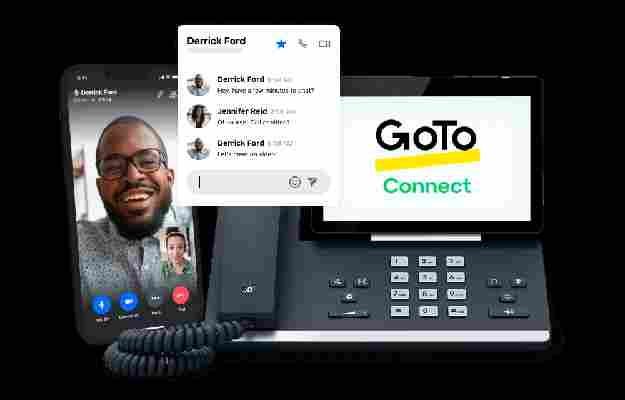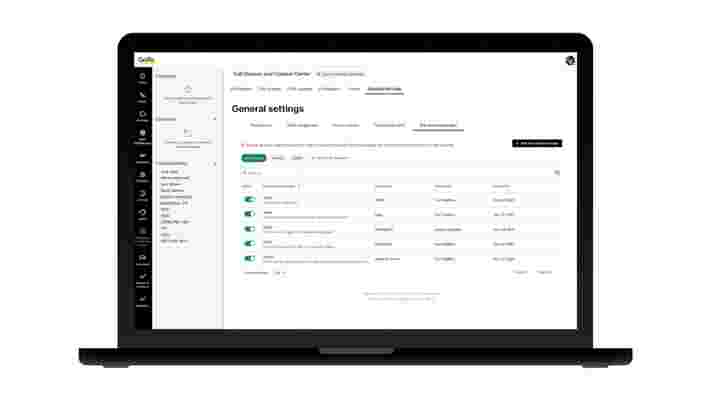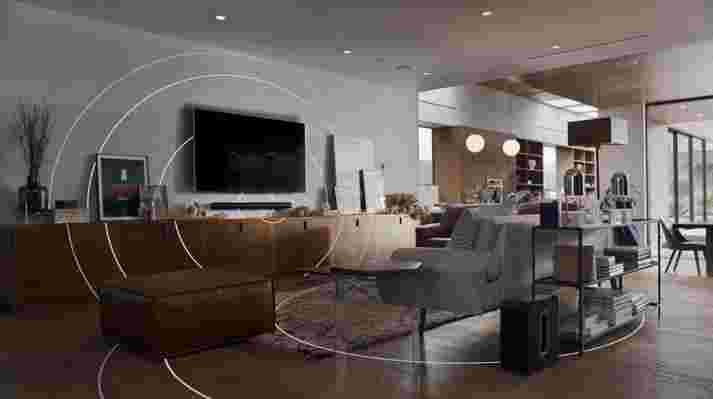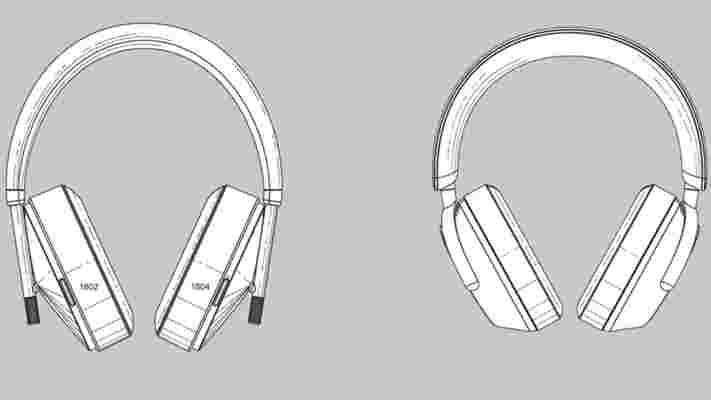With so much reliance on modern devices like smartphones and tablets, and the cloud-based communication services that power them, it’s easy to overlook the humble desk phone when it comes to speccing out a remote working strategy. For many small businesses, however, desk phones (and the telephony infrastructure that underpins them) are an essential part of their workflows.
This GoTo-sponsored article will explore why the functionality of desk phones is still needed in a modern organisation, and how a comms strategy which enables video conferencing, digital collaboration and traditional phone calls on an equal footing can unlock greater flexibility and more powerful hybrid working.
To say that the world of modern business has changed dramatically over the years would be something of an understatement; transplant an average worker from 1974 into a modern office, and they’d probably go into shock-induced catatonia. Our working lives have gradually been transformed, modernised and revolutionised, and almost all of these changes have been the result of a growing evolution in technology.
A series of innovations - first email, then the internet, followed by smartphones, video conferencing and the cloud - have made us more connected, more productive and more versatile. Even over the past two years, a pandemic-induced wave of remote working has driven tectonic shifts in our attitudes to business collaboration. Back in 2019, the idea of hybrid work being a widely accepted standard would have been all but unthinkable, but modern technology allowed us to make the jump without sacrificing our ability to connect with our colleagues.

Don’t overlook the humble phone call
Despite the phenomenal leaps in technology that successive decades have delivered, there’s one element of professional communication that has remained a steadfast constant: the humble phone call. For more than a century, the telephone has been one of the most reliable methods for conducting business, maintaining relationships and reaching out to new clients and partners, and it doesn’t show any signs of fading from relevance.
There’s a good reason for this, too; a study by the University of Texas in 2020 found that talking on the phone made people feel far more comfortable and connected, and resulted in the formation of stronger bonds, than exchanging emails or chatting via text. Simply put, human beings are hard-wired to respond positively to the sound of each other’s voices in ways that other forms of communication simply can’t replicate.
In a business environment that relies on forming and reinforcing strong connections with customers, suppliers and partners, this makes phone calls a vital tool in any organisation’s arsenal. This is particularly true for small businesses, where outbound sales may form a significant part of their go-to-market strategy.
Why desk phones should be part of your hybrid work strategy
Interestingly, despite the importance of phone calls as a business enabler, telephony is often overlooked by organisations when planning their hybrid working strategy. While digital collaboration and video conferencing platforms are (rightly) highlighted as central components for supporting transformation projects, landlines and desk phones are often the first things to go when implementing flexible working, hot-desking or any other modern agility initiatives.
The logic behind this is reasonably straightforward - we all have a mobile phone which we constantly carry around with us, usually with a reasonably generous calling plan, so any phone calls that need to be made can be done using those. Some organisations will even pay for a company-provided device with its own dedicated contract and phone number. At first glance, this would appear to be enough, but businesses which don’t advance their telephony strategy beyond this risk missing out on a multitude of opportunities and advantages which a properly-integrated digital phone solution can offer.
For example, if a partner or prospective customer calls one of your salespeople on their personal mobile, but that salesperson is currently unavailable, then they’ll miss the call - at which point, the caller will either leave a voicemail message, or (more likely) will simply hang up and go on with their day. That employee will then need to call them back (hoping to catch them at a good time) before the transaction can proceed - and this process of telephone tag can go on for days, if not weeks.
A modern digital telephony platform like GoTo Connect , however, includes the ability to create detailed and customised call handling rules. This allows businesses to design their system so that if the target recipient of a phone call doesn’t pick up, it’s automatically transferred to another person, such as a colleague on the same team. You can also set up ring groups so that when someone calls an extension, multiple phones ring simultaneously, maximising the chances that someone will be able to answer in a timely manner.

A seamless experience across devices
For small businesses, digital phone systems offer a range of tools which can help them replicate the customer experience one would expect from a much larger organisation. Digital receptionists can be used to route callers through to the appropriate department in a friendly and engaging way, while call queues ensure that a limited number of employees doesn’t result in missed calls and missed opportunities. If you inject some of your business’s personality into the process, you can even set custom hold music.
Crucially, this also doesn’t rely on remaining shackled to desk phones. Thanks to the flexibility of the cloud, platforms like GoTo Connect can offer a seamless experience across digital desk phones, mobile devices and desktop PCs, allowing staff to make and manage calls with the same level of flexibility and functionality whether they’re at home or in the office. In fact, you can even switch from one to the other in the middle of an active call.

In addition to this, GoTo’s all-in-one administrator portal allows businesses to oversee every aspect of their unified comms estate through a single-pane-of-glass cloud management dashboard. This makes troubleshooting and remediating issues significantly easier, and eliminates the headache of having to switch between multiple portals to manage individual on-premise comms systems.
These capabilities put the power and versatility of enterprise-grade communication within reach of small businesses without requiring expensive investments in PBX infrastructure or SIP trunking. They’re especially transformational when rolled out as part of a unified strategy which places digital collaboration, video conferencing and cloud-based telephony on an equal footing.
Phone calls are, and will remain, an essential vector for business communications, and investing in a properly architected digital phone platform can supercharge both your inbound and outbound relationships, allowing your staff to better connect with your customers and partners. The future is calling - don’t let it go to voicemail.
Sonos is reportedly working on a top-secret home theater system
The Sonos ecosystem of wireless speakers and soundbars might be on the verge of a big upgrade, if rumors of a new home theater operating system are to be believed.
According to Protocol , which cites "multiple sources" who spoke on the condition of anonymity, Sonos is hiring people to work on a new Home Theater OS project, with job descriptions that suggest the company plans to run apps directly on TVs.
Sonos has apparently been considering various ways to break into TV streaming over the past few years. While the company has created the comprehensive S2 app, which allows users to control their Sonos speakers , create different groupings, and stream music, it's never made this app available on TVs.
That could all be about to change, though with Sonos posting an job ad for a UX Lead - Next Generation Home Experience. The successful candidate will "work across deliver surfaces (mobile, television, tablet, and HW remote) to deliver a next-generation content delivery experience'". Applicants need to have eight to 12 years designing UX for mobile and/or TV.

Other job listings for the project ask for applicants to have experience in modern operating systems, including Android/ Android TV , which further suggests a big focus on TV from the company.
While Sonos is yet to comment on whether it is working on a home theater operating system, we do know that the company is branching out. Sonos' chief innovation officer, Nick Millington, shared one of the job listings on LinkedIn , saying that he's working on "a new home theater project", and the role would suit anyone with experience in streaming media such as “audio, video, games, sports, music, news, movies, TV, news, podcasts.”
So, the new Sonos Home Theater OS could be pretty far-reaching, extending into lots of other kinds of content besides music streaming - perhaps even acting as a one-stop-shop for TV, radio, podcasts , gaming, and music, tying in all your various subscriptions into one place.
What about the Sonos wireless headphones?

The news that Sonos could be working on a new home theater operating system suggests that the company might not be looking to branch out into the world of headphones this year, as we had previously thought.
We've seen a few patents for wireless headphones and earbuds from the company, and as Sonos tends to release two new products a year, we were hoping that 2022 would see in the first pair of Sonos headphones .
Sonos is a big name in multiroom audio, so a pair of headphones from the company could really shake up the competition - especially if they come with Wi-Fi connectivity and the ability to 'swap' audio to other Sonos devices, like the Sonos Roam .
However, it looks like Sonos is very much focusing on the world of home cinema with its rumored operating system - and with the success of the Sonos Arc and Sonos Beam (Gen 2) soundbars in recent years, that's not a huge surprise. It's also rumored that Sonos is working on the Sonos Sub Mini , a smaller version of its popular subwoofer, so a home theater OS would compliment that nicely.
In any case, we may not have too long to wait until we find out what the next Sonos device will be. The company released its first product of 2021 in April last year, and if it wants to stick to its rather rigid release schedule, you can expect a new Sonos product to launch in the next few months.
Google Chrome OS 100 update arrives with a start menu to rival Windows 11
Google's ChromeOS for Chromebooks was also updated to version 100, alongside its web browser , showcasing a new app launcher and other features.
In a blogpost , the company spoke of the app launcher being the headline feature here, with it moving from the center to the left of the screen, similar to Windows 11 's start menu.
Searching for a term also looks cleaner here, with results being shown in a list, with the choice to look at images or news on the query. But there's also other features, such as being able to edit words with your voice and using the webcam to create gifs of yourself.
These are promising features as we approach Google IO in May , and make us wonder if we'll see some surprises at the event for Chrome OS.
Analysis: Strength to strength for Chrome OS

Around 2010, 'netbook' was a term that was associated with smaller-sized laptops that had a terrible battery life and slow speeds, with their only advantage being that they were available for a low price.
Tablets like the iPad would push these out of the way, but Google saw another route in this area with its Chromebooks, which only run on ChromeOS and offered a majority of Android apps.
These Chromebooks have only gotten better in recent years, especially for those who only do work on Google's apps. In certain places of work, employees are given Chromebooks as their sole machine, mainly due to their solid battery life and being able to easily access their work email, spreadsheets and documents through G Suite .
With Chrome OS reaching version 100 and Android 13 fast approaching, we can't help but wonder if there's going to be some announcements made at Google IO in May. Whether that's in gaming or a dedicated Pixel tablet that runs on Chrome OS instead of Android, it looks to be an encouraging time if you're all in on the Google ecosystem.